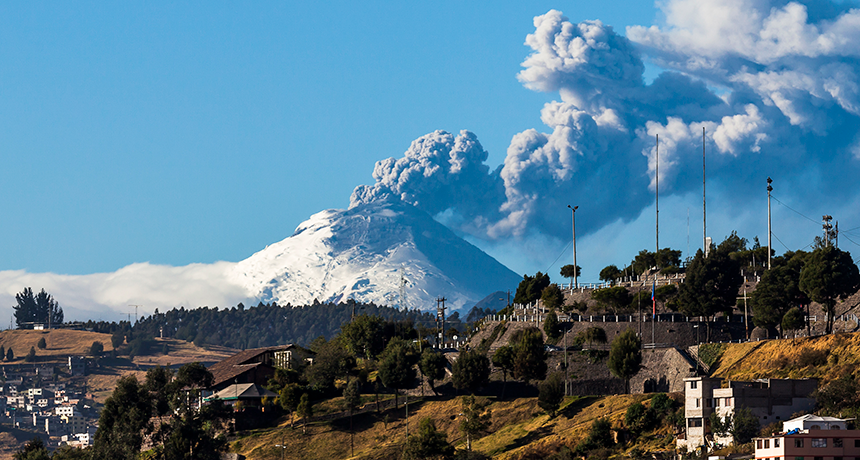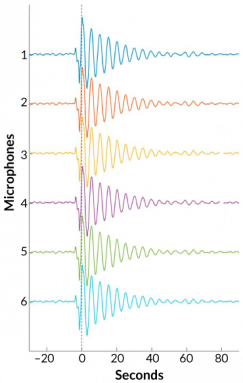After erupting, one volcano sings a unique ‘song’
The low-frequency sound ebbs and flows with the whooshing of air inside the crater

Ecuador’s Cotopaxi volcano erupted in August 2015. For several months afterward, scientists recorded odd patterns of reverberating sound.
PatricioHidalgoP/iStockphoto
The South American volcano Cotopaxi sometimes sings. But people will never hear its deep and distinct voice. Its frequency is too low for the human ear to hear. But microphones can listen in. And between late 2015 and early 2016, they heard this peak in Ecuador sign out an unusual pattern of sound. Researchers now say that pattern is due in part to the unique shape of the volcano’s crater.
Other volcanoes might have a similarly distinct “voiceprint.” Identifying it could help scientists listen for changes within a crater. Such changes might even warn of an upcoming eruption.
Scientists from Ecuador installed a network of microphones on Cotopaxi’s flanks. They could record the very low frequency infrasound. Two weeks after the volcano’s August 2015 eruption, the network recorded the unusual acoustic pattern. It showed a strong, clear oscillation. The sound curve resembles a screw — or “tornillo,” in Spanish — that tapered off with time.
Scientists described the volcano’s distinctive call in the June 16 Geophysical Research Letters.
Cotopaxi repeated this tornillo pattern 37 times between September 2015 and April 2016. Each time, the signal lasted through a dozen or more oscillations. It resonated much like a musical instrument, before dying away.
Indeed, notes study leader Jeffrey Johnson, the volcano “rang like a bell for more than a minute.” A geophysicist, he works at Boise State University in Idaho.
Too low to hear

Scientists have been listening to infrasound volcano calls for about two decades. These sound waves have frequencies between about 0.01 hertz and 20 Hz. That’s far too low for the human ear to hear. (It is audible to some animals, however, including elephants.) These low acoustic signals are helping scientists study everything from volcanic eruptions to the movement of volcano-induced mudflows, known as lahars.
“If you didn’t have infrasonic sensors, you wouldn’t pick up any of this,” Johnson says. “You would be deaf to this world of unique and beautiful sounds.”
Among recorded volcanos, Cotopaxi’s voice is unusually deep. It’s like a baritone among tenors. The volcano resonates at around 0.2 Hz. That’s a frequency about one-fifth that of many other volcanoes. Johnson’s team attributes this strange voiceprint to air sloshing back and forth within Cotopaxi’s deep, cylinder-shaped crater.
What triggered the sound oscillation after the initial 2015 eruption is difficult to figure out. Scientists looked at video from a nearby webcam. Based on that, Johnson suspects the culprit may be the off-and-on release of gases from the crater’s magma lake.
Other volcanoes may not speak in screw-shaped sound bits. But Johnson suggests that they may have similarly unique voices. Monitors could identify the “voiceprints” of the most worrisome volcanoes. Then they could listen for sudden changes that might provide an early sign of volcanic unrest. For example, a volcano’s voice may change due to the rise or fall of the crater’s magma lake, he says. “Infrasound can tell us what’s happening at the surface [of an active volcano],” he says, “when we can’t walk up to the crater and peer inside.”
Seeing tornillos in volcano infrasound recordings is “a very cool thing,” says Jonathan Lees. He’s a seismologist and volcanologist who was not involved in the new study. He works at the University of North Carolina at Chapel Hill. It takes a very specific internal shape to create a tornillo, he says. That’s why it is not likely to be heard coming from many other volcanoes, he notes.
Johnson’s team listened to another bell-like crater at Congo’s Mount Nyiragongo volcano. “We did detect a low-frequency infrasound tone [coming from it],” Johnson says. However, the sounds didn’t oscillate long enough time to create a tornillo. That is likely due to the width of Nyiragongo’s crater. At 3 kilometers (1.9 miles) across, it is more bowl-shaped than pipe-shaped.
Although Cotopaxi’s call is too low for the human ear to hear, researchers re-created the tornillo pattern. They used oscillations in white noise. It shares the same amplitude pattern as the original tornillo signal, but those oscillations are at twice the speed of those in the volcano’s original call.
Credit: AGU







